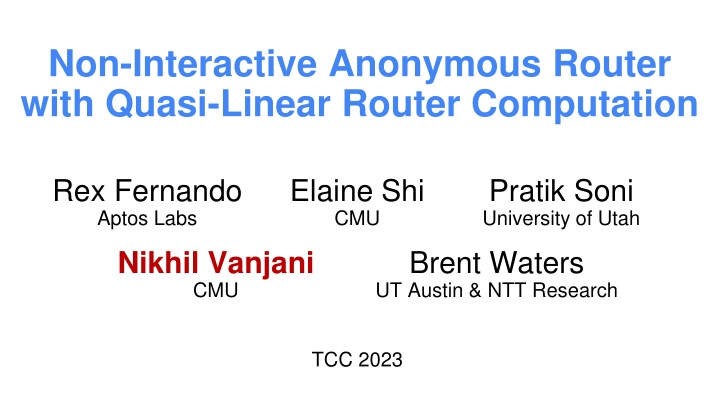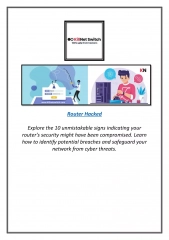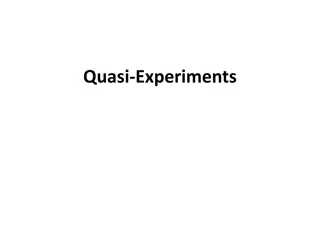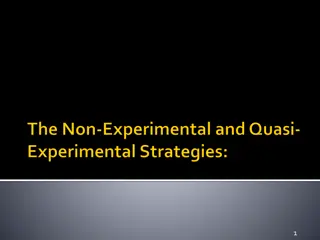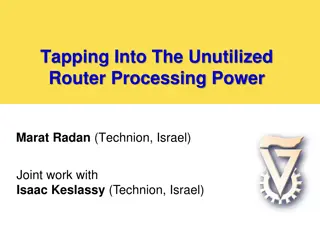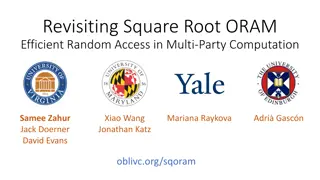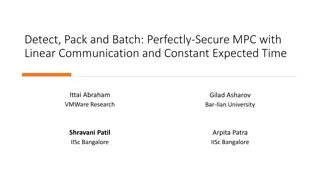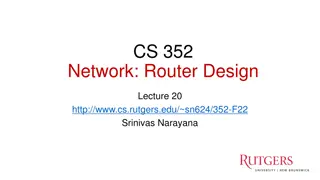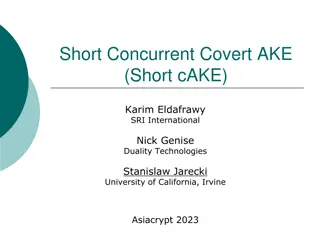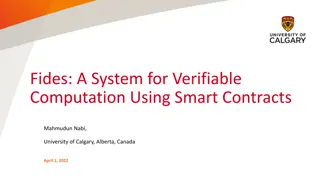Non-Interactive Anonymous Router with Quasi-Linear Computation
Explore the concept of a Non-Interactive Anonymous Router with Quasi-Linear Computation, Receiver Insider Protection (RIP), Sender Insider Protection (SIP), and Multi-Client Functional Encryption. The comparison of anonymity notions in NIAR and the motivation behind the non-interactive anonymous shuffler are also discussed.
Download Presentation

Please find below an Image/Link to download the presentation.
The content on the website is provided AS IS for your information and personal use only. It may not be sold, licensed, or shared on other websites without obtaining consent from the author.If you encounter any issues during the download, it is possible that the publisher has removed the file from their server.
You are allowed to download the files provided on this website for personal or commercial use, subject to the condition that they are used lawfully. All files are the property of their respective owners.
The content on the website is provided AS IS for your information and personal use only. It may not be sold, licensed, or shared on other websites without obtaining consent from the author.
E N D
Presentation Transcript
Non-Interactive Anonymous Router with Quasi-Linear Router Computation Rex Fernando Aptos Labs Elaine Shi CMU Pratik Soni University of Utah Brent Waters UT Austin & NTT Research Nikhil Vanjani CMU TCC 2023
Non-Interactive Anonymous Router (NIAR) [SW21] s1 s2 s3 s4 sn n senders Single, untrusted router permutation r1 r2 r3 r4 rn n receivers 2
Non-Interactive Anonymous Router (NIAR) [SW21] Setup Setup s1 s2 s3 s4 sn n senders Encrypt Encrypt Single, untrusted router Route Route permutation Decrypt r1 r2 r3 r4 rn n receivers 3
NIAR Anonymity: Receiver Insider Protection (RIP) Simple example: adversary corrupts the router, all receivers, and all but 2 senders. corrupt sender: Adversary allowed to learn the receiver Adversary cannot infer destinations of s1and s2 s1 s2 s3 s3 s4 s4 sn sn Single, untrusted router corrupt receiver: want to protect the anonymity of the sender r1 r1 r2 r2 r3 r3 r4 r4 rn rn 4
Comparison of Anonymity Notions in NIAR Receiver Insider Protection (RIP) protect the anonymity of senders of corrupt receivers. More challenging! Multi-Client Functional Encryption with function-hiding security [SW21] Known from: standard assumptions on pairings [SW21, AGT21, SV23] Sender Insider Protection (SIP) protect the anonymity of receivers of corrupt senders. Private Information Retrieval [BKO23] Known from: standard assumptions such as DDH, QR, LWE, etc. [DGI+19, HHCG+22 , MW22, ] 5
Our Motivation: Non-Interactive Anonymous Shuffler s1 s2 s3 s4 sn Single, untrusted shuffler Shuffled messages 6
Our Motivation: Non-Interactive Anonymous Shuffler Implement as NIAR s1 s2 s3 s4 sn Single, untrusted router Crucially requires Receiver Insider Protection! r1 r2 r3 r4 rn Sender Insider Protection is insufficient! Single, untrusted shuffler 7
Prior Work: NIAR with Receiver Insider Protection [SW21] O(n) communication Without anonymity, we can get O(n) router computation! O(n2) router computation Cryptographic assumptions: Decisional linear assumption on bilinear maps Build NIAR scheme with sub-quadratic router computation? 8
Our Main Result NIAR with Receiver Insider Protection O(n log n) communication n polylog(n) router computation Near-Optimal Cryptographic assumptions: One-way functions, indistinguishability obfuscation (iO) Concurrent Work: NIAR with Sender Insider Protection [BKO23] Incomparable; different applications 9
Roadmap 1. Strawman: Single iO Program 2. Our NIAR Construction: Network of small iO Programs 3. How to use iO: SSU Signatures 10
Indistinguishability Obfuscation (iO) Known from well-studied assumptions [JLS21] obfuscate P iO[P] equivalent indistinguishable obfuscate Q iO[Q] 11
Strawman: Single iO Program s1 s2 s3 s4 sn Obfuscation of program: Secrets: , Decrypt all ciphertexts using sender keys Permute plaintexts according to Re-encrypt plaintexts using receiver keys ,..., : r1 r2 r3 r4 rn 12
Strawman: Single iO Program Problem 1: known iO constructions incur poly blow up in eval time. Original program: O(n) time => iO program: poly(n) time. 1 2 3 4 n Obfuscation of program: Secrets: , Decrypt all senders ciphertexts Permute plaintexts according to Re-encrypt plaintexts Gates in a routing network ,..., : Solution: Network of small iO programs r1 r2 r3 r4 rn 13
Roadmap 1. Strawman: Single iO Program 2. Our NIAR Construction: Network of small iO Programs 3. How to use iO: SSU Signatures 14
Routing Network [ACN+20, RS21] s1 s2 s3 s4 All receivers are reachable from every sender! Gate11 Gate12 Layer 1 i i i i Gate21 Gate22 Layer 2 Can simulate permutation r1 r2 r3 r4 15
Simple Routing Network is not Anonymous s1 s2 s3 s4 Gate11 Gate12 Layer 1 i i i i Gate21 Gate22 Layer 2 r1 r2 r3 r4 Adversary can infer that s2is sending to r3 16
Filler Wires: enable Anonymity in Routing Networks s1 f s2 f s3 f s4 f Gate11 Gate12 Layer 1 i i i i i i i i Gate21 Gate22 Layer 2 r1 f r2 f r3 f r4 f Adversary can t infer if s2is sending to r2or r3 17
Our Construction: Network of iO Obfuscate all gates of routing network s1 f s2 f s3 f s4 f Router emulates all this Gate11 iO[Gate11] Gate12 iO[Gate12] i i i i i i i i Problem: adversary can mix-n-match wires Gate21 iO[Gate21] Gate22 iO[Gate22] Gates must do authentication checks r1 f r2 f r3 f r4 f 18
Gate circuit: Decrypt ciphertexts to obtain signed messages Verify signature on each message Permute messages Sign messages Re-encrypt signed messages 19
Efficiency Number of gates: O(n log n) Running time: 1 gate: poly(log n) 1 obfuscated gate: poly(log n) Router: n poly(log n) 20
Roadmap 1. Strawman: Single iO Program 2. Our NIAR Construction: Network of small iO Programs 3. How to use iO: SSU Signatures 21
Somewhere Statistically Unforgeable (SSU) Signatures* Normal mode: Normal signing key Normal verification key Binding mode: Binding signing key: no messages in a set X can be signed Binding verification key: no valid signatures exist for messages in set X Statistical unforgeability holds somewhere, i.e., set X *Simplified description. Check paper for exact formulation. 22
Security of SSU Signatures* Not satisfied by known puncturable signature schemes [HIJ+17, BSW16, GWZ22] For our network of iO proof to go through, need indistinguishability of normal and binding keys: SSU Signatures construction from one-way functions + iO *Simplified description. Check paper for exact formulation. 23
Additional Results Initiate the study of adaptive corruptions Indistinguishability security: Static NIAR => Adaptive NIAR Works for receiver-insider protection [SW21, this work], sender-insider protection [BKO23], differential anonymity [BHMS21] Simulation security: Impossibility Result via compression argument [DTT10, GT20] 24
Take away: iO is not only a tool to build complex cryptographic primitives, but it can also be a tool to boost efficiency of systems. Open Questions Better Cryptographic Assumptions Efficient NIAR from standard assumptions without using iO? Network of iO approach to boost efficiency More applications beyond the routing task? Boost efficiency of iO itself? 25
Thank You! https://eprint.iacr.org/2022/1395 nvanjani@cmu.edu 26
Security property of binding keys? Hyb0 Hyb1 Hyb2 Hyb3 Gate11 normal vk11 normal sk21 Gate11 binding vk11 normal sk21 Gate11 binding vk11 binding sk21 Gate11 binding vk11 binding sk21 Layer 1 Gate21 normal vk21 Gate21 normal vk21 Gate21 normal vk21 Gate21 binding vk21 Layer 2 Indistinguishability of normal and binding keys iO security 28
